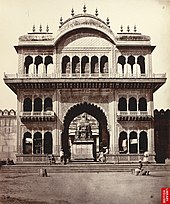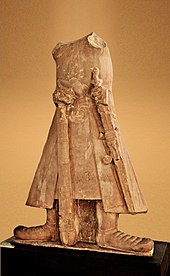Mathura is a city in the North Indian state of Uttar Pradesh. It is located approximately 50 kilometres (31 mi) north of Agra, and 145 kilometres (90 mi) south-east of Delhi; about 11 kilometres (6.8 mi) from the town of Vrindavan, and 22 kilometres (14 mi) from Govardhan. It is the administrative centre of Mathura district of Uttar Pradesh. In ancient times, Mathura was an economic hub, located at the junction of important caravan routes. The 2011 Census of India estimated the population of Mathura to be 441,894.
In Hinduism, Mathura the birthplace of Krishna, which is located at the Krishna Janmasthan Temple Complex. It is one of the Sapta Puri, the seven cities considered holy by Hindus. The Kesava Deo Temple was built in ancient times on the site of Krishna's birthplace (an underground prison). Mathura was the capital of the kingdom of Surasena, ruled by Kansa, the maternal uncle of Krishna.
Mathura has been chosen as one of the heritage cities for Heritage City Development and Augmentation Yojana scheme of Government of India.
Mathura has an ancient history and also believed to be the homeland and birthplace of Krishna who was born in Yadu dynasty. According to the Archaeological Survey of India plaque at the Mathura Museum, the city is mentioned in the oldest Indian epic, the Ramayana. In the epic, the Ikshwaku prince Shatrughna slays a demon called Lavanasura and claims the land. Afterwards, the place came to be known as Madhuvan as it was thickly wooded, then Madhupura and later Mathura.
Archaeological excavations at Mathura show the gradual growth of a village into an important city. The earliest period belonged to the Painted Grey Ware culture (1100-500 BCE), followed by the Northern Black Polished Ware culture (700-200 BCE). Mathura derived its importance as a center of trade due to its location where the northern trade route of the Indo-Gangetic Plain met with the routes to Malwa (central India) and the west coast.
By the 6th century BCE Mathura became the capital of the Surasena Kingdom. The city was later ruled by the Maurya empire (4th to 2nd centuries BCE). Megasthenes, writing in the early 3rd century BCE, mentions Mathura as a great city under the name Μέθορα (Méthora) It seems it never was under the direct control of the following Shunga dynasty (2nd century BCE) as not a single archaeological remain of a Shunga presence were ever found in Mathura.
The Indo-Greeks may have taken control, direct or indirect, of Mathura some time between 180 BCE and 100 BCE, and remained so as late as 70 BCE according to the Yavanarajya inscription, which was found in Maghera, a town 17 kilometres (11 mi) from Mathura. The opening of the 3 line text of this inscription in Brahmi script translates as: "In the 116th year of the Yavana kingdom..." or '"In the 116th year of Yavana hegemony" ("Yavanarajya") However, this also corresponds to the presence of the native Mitra dynasty of local rulers in Mathura, in approximately the same time frame (150 BCE—50 BCE), possibly pointing to a vassalage relationship with the Indo-Greeks.
After a period of local rule, Mathura was conquered by the Indo-Scythians during the first 1st century BCE. The Indo-Scythian satraps of Mathura are sometimes called the "Northern Satraps", as opposed to the "Western Satraps" ruling in Gujarat and Malwa. However, Indo-Scythian control proved to be short lived, following the reign of the Indo-Scythian Mahakshatrapa ("Great Satrap") Rajuvula, c. 10–25 CE.
The Kushan Empire took control of Mathura some time after Rajuvula, although several of his successors ruled as Kushans vassals, such as the Indo-Scythian "Great Satrap" Kharapallana and the "Satrap" Vanaspara, both of whom paid allegiance to the Kushans in an inscription at Sarnath, dating to the 3rd year of the reign of the Kushan emperor Kanishka c. 130 CE. Mathuran art and culture reached its zenith under the Kushan dynasty which had Mathura as one of its capitals. The preceding capitals of the Kushans included Kapisa (modern Bagram, Afghanistan), Purushapura (modern Peshawar, Pakistan) and Takshasila/Sirsukh/ (modern Taxila, Pakistan). Faxian mentions the city as a centre of Buddhism about 400 CE while his successor Xuanzang, who visited the city in 634 CE, mentions it as Mot'ulo, recording that it contained twenty Buddhist monasteries and five Brahmanical temples. Later, he went east to Thanesar, Jalandhar in the eastern Punjab, before climbing up to visit predominantly Theravada monasteries in the Kulu valley and turning southward again to Bairat and then Mathura, on the Yamuna river.
The city was sacked and many of its temples destroyed by Mahmud of Ghazni in 1018 CE and again by Sikandar Lodhi, who ruled the Sultanate of Delhi from 1489 to 1517 CE. Sikander Lodhi earned the epithet of 'Butt Shikan', the 'Destroyer of Hindu deities'. The Mughal Emperor Aurangzeb, built the Shahi-Eidgah Mosque during his rule, which is adjacent to Shri Krishna Janmabhoomi believed to be over a Hindu temple
Posted By: vipul Koul
In Hinduism, Mathura the birthplace of Krishna, which is located at the Krishna Janmasthan Temple Complex. It is one of the Sapta Puri, the seven cities considered holy by Hindus. The Kesava Deo Temple was built in ancient times on the site of Krishna's birthplace (an underground prison). Mathura was the capital of the kingdom of Surasena, ruled by Kansa, the maternal uncle of Krishna.
Mathura has been chosen as one of the heritage cities for Heritage City Development and Augmentation Yojana scheme of Government of India.
History
Mathura in 1949
Gate of Shet Lukhmeechund's Temple, a photo by Eugene Clutterbuck Impey, 1860's.
Statue of Kanishka I, 2nd century CE, Mathura Museum.
Sculpture of woman from ancient Braj-Mathura ca. 2nd century CE.
Archaeological excavations at Mathura show the gradual growth of a village into an important city. The earliest period belonged to the Painted Grey Ware culture (1100-500 BCE), followed by the Northern Black Polished Ware culture (700-200 BCE). Mathura derived its importance as a center of trade due to its location where the northern trade route of the Indo-Gangetic Plain met with the routes to Malwa (central India) and the west coast.
By the 6th century BCE Mathura became the capital of the Surasena Kingdom. The city was later ruled by the Maurya empire (4th to 2nd centuries BCE). Megasthenes, writing in the early 3rd century BCE, mentions Mathura as a great city under the name Μέθορα (Méthora) It seems it never was under the direct control of the following Shunga dynasty (2nd century BCE) as not a single archaeological remain of a Shunga presence were ever found in Mathura.
The Indo-Greeks may have taken control, direct or indirect, of Mathura some time between 180 BCE and 100 BCE, and remained so as late as 70 BCE according to the Yavanarajya inscription, which was found in Maghera, a town 17 kilometres (11 mi) from Mathura. The opening of the 3 line text of this inscription in Brahmi script translates as: "In the 116th year of the Yavana kingdom..." or '"In the 116th year of Yavana hegemony" ("Yavanarajya") However, this also corresponds to the presence of the native Mitra dynasty of local rulers in Mathura, in approximately the same time frame (150 BCE—50 BCE), possibly pointing to a vassalage relationship with the Indo-Greeks.
After a period of local rule, Mathura was conquered by the Indo-Scythians during the first 1st century BCE. The Indo-Scythian satraps of Mathura are sometimes called the "Northern Satraps", as opposed to the "Western Satraps" ruling in Gujarat and Malwa. However, Indo-Scythian control proved to be short lived, following the reign of the Indo-Scythian Mahakshatrapa ("Great Satrap") Rajuvula, c. 10–25 CE.
The Kushan Empire took control of Mathura some time after Rajuvula, although several of his successors ruled as Kushans vassals, such as the Indo-Scythian "Great Satrap" Kharapallana and the "Satrap" Vanaspara, both of whom paid allegiance to the Kushans in an inscription at Sarnath, dating to the 3rd year of the reign of the Kushan emperor Kanishka c. 130 CE. Mathuran art and culture reached its zenith under the Kushan dynasty which had Mathura as one of its capitals. The preceding capitals of the Kushans included Kapisa (modern Bagram, Afghanistan), Purushapura (modern Peshawar, Pakistan) and Takshasila/Sirsukh/ (modern Taxila, Pakistan). Faxian mentions the city as a centre of Buddhism about 400 CE while his successor Xuanzang, who visited the city in 634 CE, mentions it as Mot'ulo, recording that it contained twenty Buddhist monasteries and five Brahmanical temples. Later, he went east to Thanesar, Jalandhar in the eastern Punjab, before climbing up to visit predominantly Theravada monasteries in the Kulu valley and turning southward again to Bairat and then Mathura, on the Yamuna river.
The city was sacked and many of its temples destroyed by Mahmud of Ghazni in 1018 CE and again by Sikandar Lodhi, who ruled the Sultanate of Delhi from 1489 to 1517 CE. Sikander Lodhi earned the epithet of 'Butt Shikan', the 'Destroyer of Hindu deities'. The Mughal Emperor Aurangzeb, built the Shahi-Eidgah Mosque during his rule, which is adjacent to Shri Krishna Janmabhoomi believed to be over a Hindu temple
Demographics
The 2011 census of India estimates the population of Mathura to be 441,894, a decadal growth rate of 22.53 per cent from 2001 census of India. Males account for 54% (268,445) and females for 46% (173,449) of this population. Sex ratio of Mathura is 858 females per 1000 males, which has increased from 840 in 2001. However, national sex ratio is 940. Population density in 2011 has increased from 621 per km2 in 2001 to 761 per km2. Mathura has an average literacy rate of 72.65 per cent which has increased from 61.46 percent in 2001 but still lower than the national average of 74.04 per cent. Male and female literacy rate are 84.39 and 58.93 per cent respectively. 15.61 percent of Mathura's population is under 6 years of age. This figure was 19.56 per cent in 2001 census.[19] Mathura has large population of Jat in rural areas and Brahmins & Baniyas in urban areasPosted By: vipul Koul







No comments:
Post a Comment